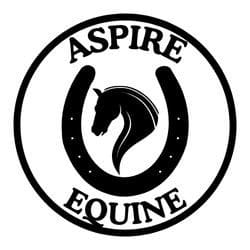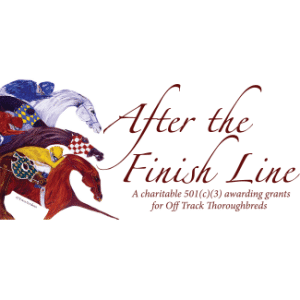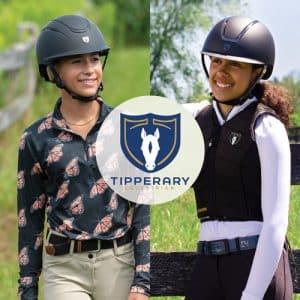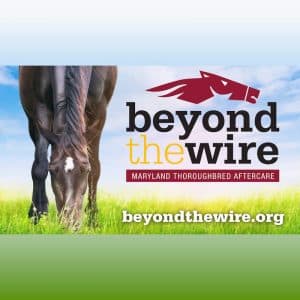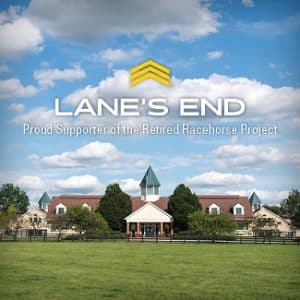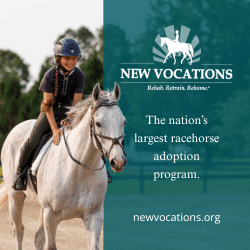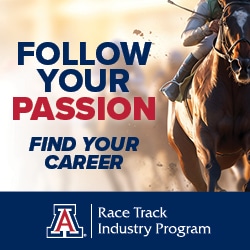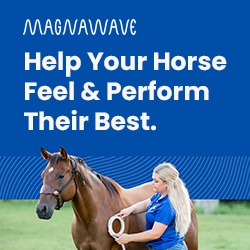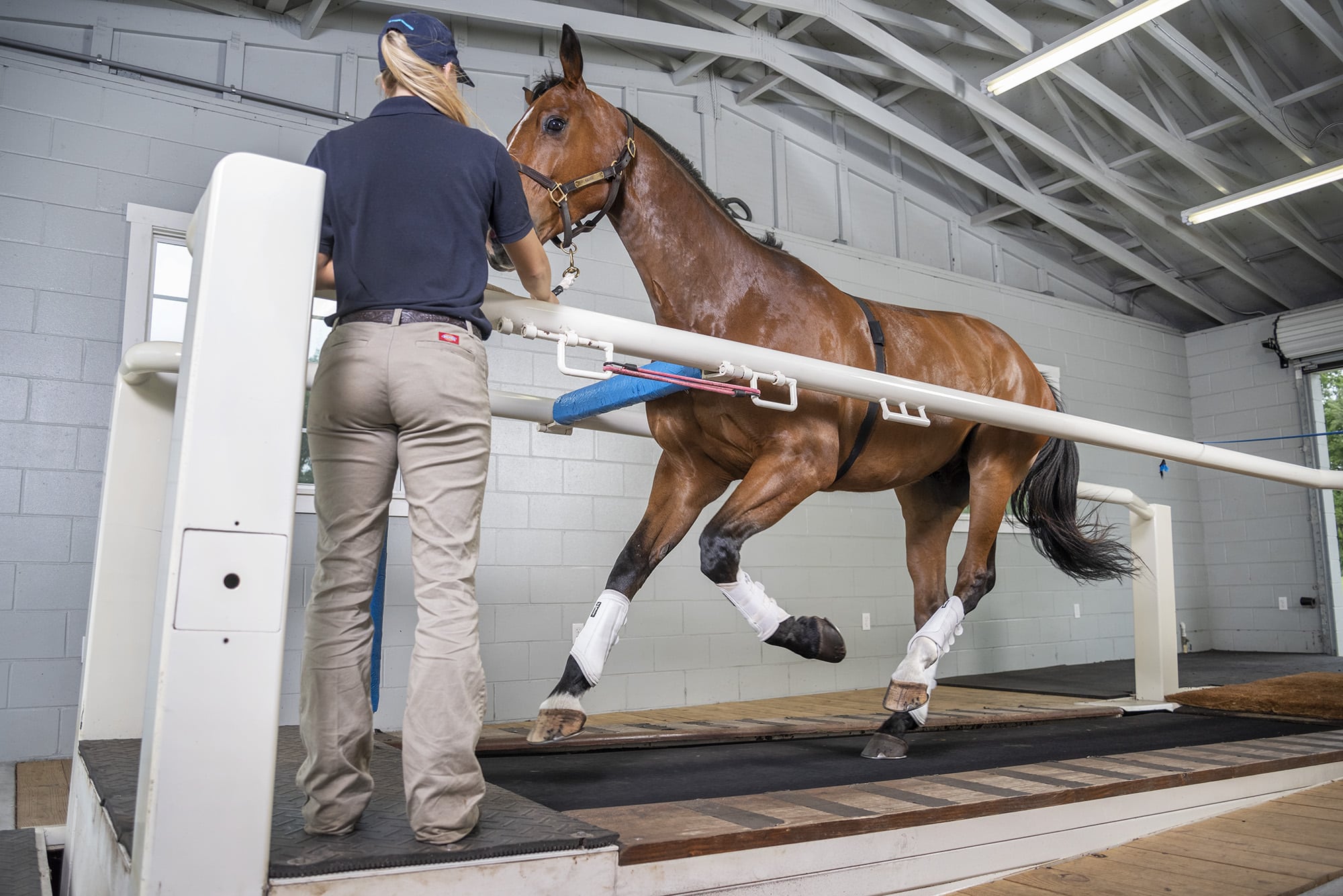
The Thoroughbreds at Kentucky Equine Research participate in a variety of nutrition and exercise physiology tests. Courtesy Mark Barrett
When their racing careers are finished — or if they never made it to the track — Thoroughbreds can play important roles in furthering scientific knowledge. By serving as research subjects, training models or even medical donors, off-track Thoroughbreds (OTTBs) often live pampered lives in research facilities while contributing to better health and welfare for horses worldwide.
Happy Lives While Working to Share Knowledge
The research herd at Kentucky Equine Research, in Versailles, is made up exclusively of OTTBs, says its president, Joe Pagan, PhD — who also owns racing Thoroughbreds.
Filling his research pastures with Thoroughbreds was an obvious choice, Pagan says, in large part because it offers a good place for animals that deserve such great treatment. “I’m a big proponent of giving racehorses happy, productive second careers,” he says. “It’s really an obligation.”
His company’s research horses benefit from top-quality, evidence-based care on the company’s “resort,” as he calls it. Meanwhile, they participate in a variety of minimally invasive nutrition and exercise physiology tests — none of which causes the horses any harm, he adds.
“If they come to us, they’ve won the lottery,” Pagan says. “And they’re also making a very meaningful contribution to knowledge, so we really appreciate that.”
The Thoroughbreds in the education program herd at the University of Kentucky, in nearby Lexington, also lead very comfortable lives, says Laurie Lawrence, PhD, professor of equine nutrition in the university’s Department of Animal and Food Sciences. Comprising both raced and unraced Thoroughbreds, the herds serve as models for hands-on education, allowing students and public training participants alike to learn to take vital signs, score body condition and even acquire good handling skills.
“Our horses are not research horses, and they’re not teaching horses,” she says. “They’re horses that fulfill the mission of the university, which is to create new knowledge and then disseminate that through educational programs. So they’re serving as instructors, and they’re disseminating knowledge out into the public.”
In the summer the program’s Thoroughbreds are usually busy trying out different kinds of pasture grasses, Lawrence says. Scientists check to see how well those grasses hold up to grazing, determine whether the horses like eating them and compare the preferred and nonpreferred grasses’ nutritional values. “So we’re really trying to gain new knowledge that we can then put back out into the horse industry, to help horse owners with their own horses,” she explains.
Farther southeast, OTTBs make up a third of the orthobiologics donor herd at North Carolina State University’s College of Veterinary Medicine, in Raleigh, says Lauren Schnabel, DVM, PhD, Dipl. ACVS, ACVSMR, associate professor of equine orthopedic surgery. The horses “live with their buddies” in open pastures, receive regular health and farrier care and get daily affection, treats and grooming.
“I treat them like my own personal horses, which also include an OTTB,” Schnabel says.
Their occasional blood collection allows for the generation of state-of-the-art biological products from a disease-free closed herd. These biological products are helping heal damaged tissues and treat septic arthritis (infected joints) in horses at NC State and hopefully soon around the world, she says.
Why OTTBs?
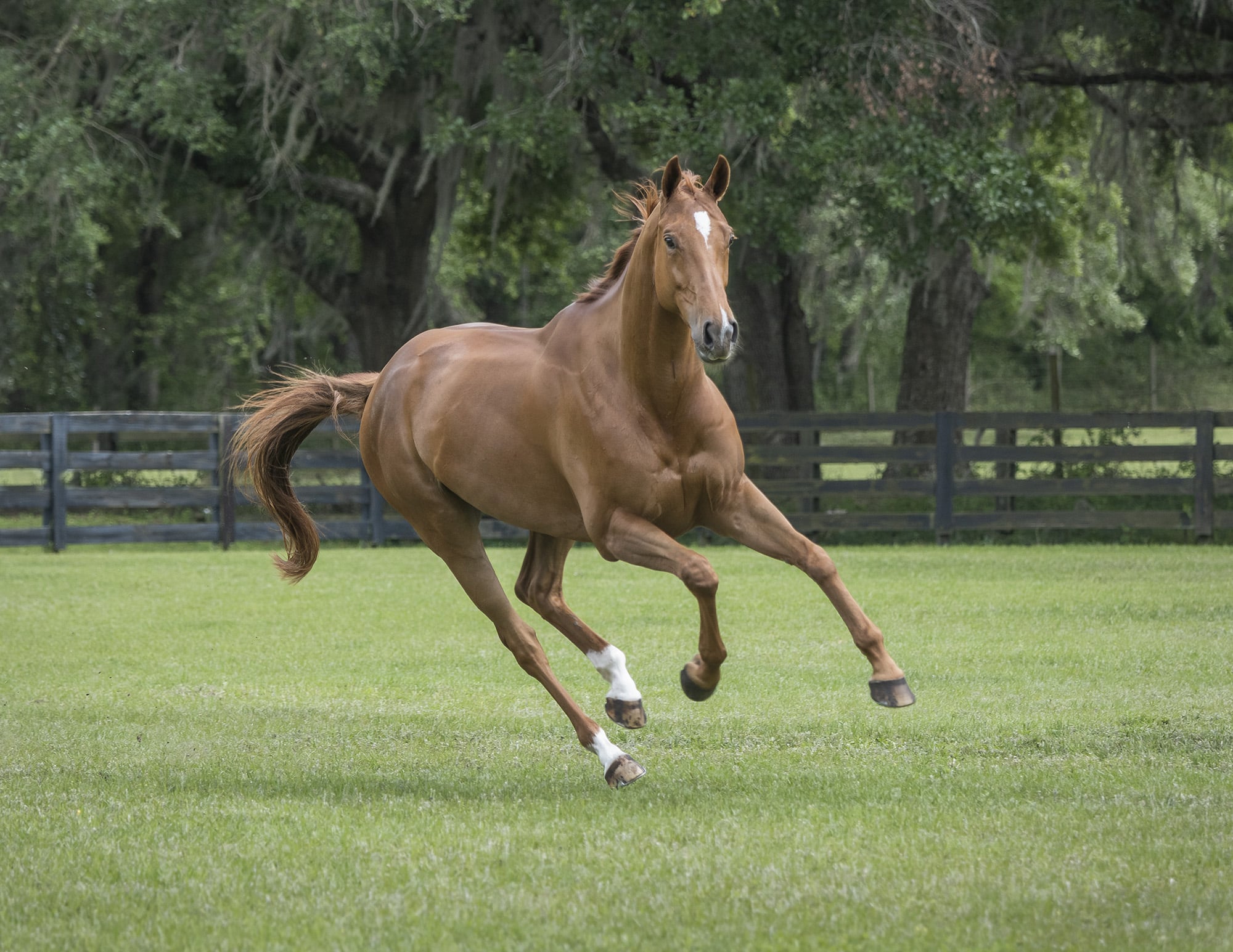
The research horses at KER and our other sources’ institutions have good care and lifetime homes. Courtesy Mark Barrett
For Pagan, it’s important to study the effects of nutrition and exercise on Thoroughbred racehorses in a controlled setting, he says. Because it’s hard to get such control in “the real world” — because horses are trained differently, on different sites, with different kinds of care and management — he finds the most robust science in his mock-racehorse research herd.
“We have a racetrack in Ocala, Florida, where the younger horses are put into training just like racehorses, with exercise riders and exercise tack, just as if they would really race,” he says.
In fact, some of horses in the Kentucky Equine Research herd show so much promise during their controlled research training, Pagan sends them to the track for a while, he adds. Others show enough potential as sport horses that he loans them out to eventing riders. And when the horses are done with their racing or eventing stints, or both, they have a secure home waiting for them back in the research herd. “They have a lot of different career paths,” he says.
In Lawrence’s program Thoroughbreds replaced Quarter Horses about 25 years ago for cultural and educational reasons. “We decided that since Thoroughbreds were the signature breed (in Central Kentucky), we probably ought to be using those, so that our students could be exposed to them,” she says. “It’s important for them to be able to see those horses and learn about them.”
Thoroughbreds also offer a wide variety of body shapes — despite having a reputation for being long and lean — which is useful for studies and education. “There are all different types — from tall and rangy to short and stocky, so it’s nice to be able to have that range,” Lawrence says.
Financial responsibility contributes to Lawrence’s decision to use OTTBs in her program, as well. Whereas Pagan often buys his study horses off the track or at yearling auctions, Lawrence usually receives horses that have been donated to her program. That helps keep the public university’s budget running on fewer taxpayer dollars, she says.
Like Pagan, Lawrence says she has a strong sense of just doing what’s right for the horse by giving these animals a home and a purpose — whether they’ve retired from a successful racing career or never got the chance to start one. “If a filly gets caught by the fence or something like that when she’s a yearling, and she’s not going to get to race, she’s still perfectly useful for many types of activities,” Lawrence says.
Even so, if a potential donor horse has a veterinary issue that would be expensive to treat over the long term, the same sense of financial responsibility toward taxpayers comes into play, she adds. “We probably wouldn’t be able to take that horse,” she says.
Temperament and Training
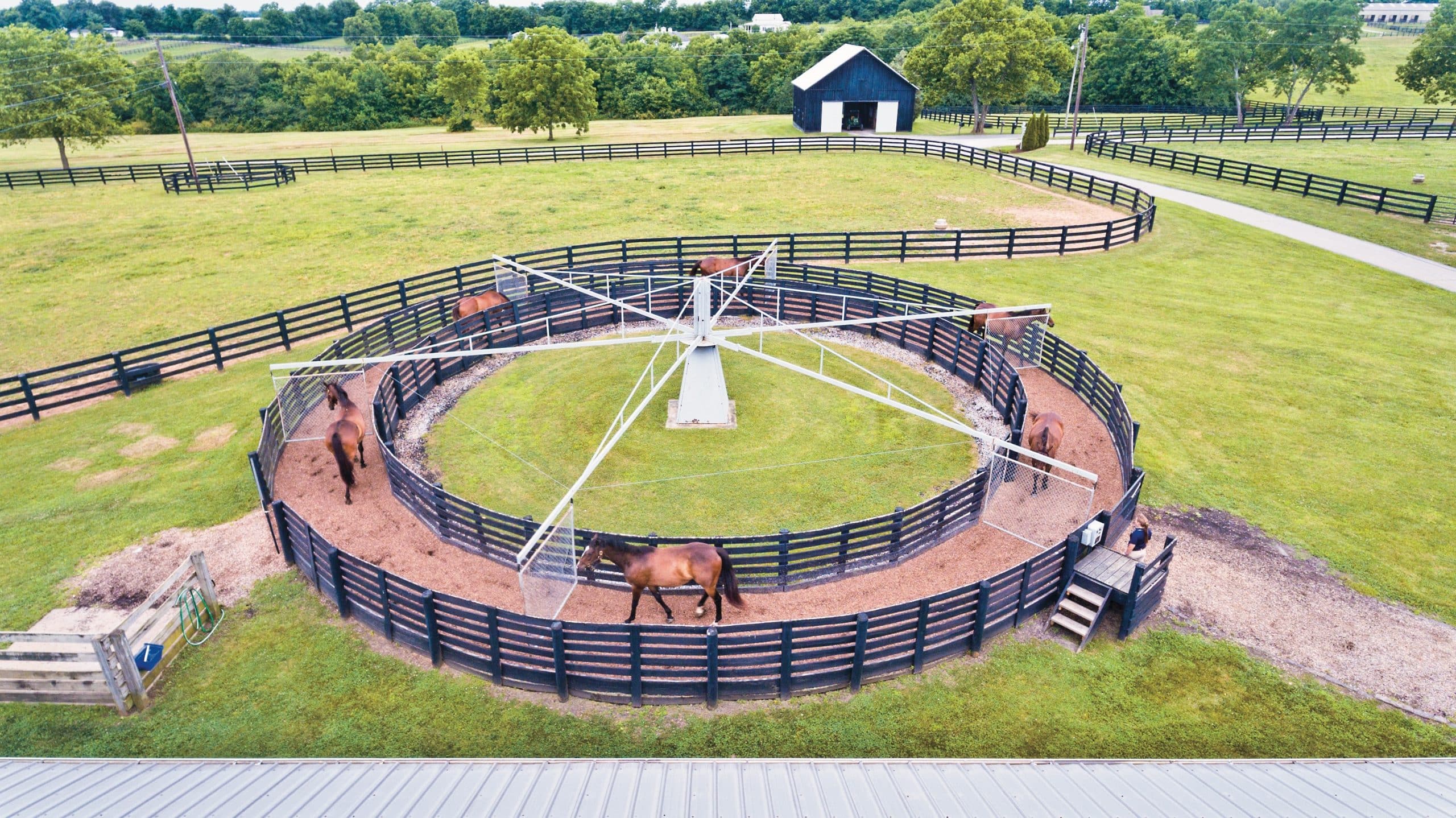
Because of their extensive training and handling on the track, OTTBs are often well-mannered and easy to work with in research settings. Courtesy KER/Matt Wooley
The Thoroughbreds working in these three science programs are all easy to work with, our sources say.
“There’s this terrible connotation that racehorses are crazy and you can’t do anything with them,” Pagan says. “We’ve found just the opposite.”
In fact, “they’ve had a lot more training and handling, so they’re used to standing still, getting groomed, being tied up and that sort of thing,” he says. “You know, they’ve kind of ‘been to college,’ so to speak.”
Despite — or perhaps because of — that additional experience, OTTBs generally need a bit of an acclimation period coming from their life as athletes into the research and education field, says Lawrence. In particular, they need transition time at pasture for a few months before they feel comfortable in the university herd. “They’re like city dwellers,” she says. “Most of them have lived indoors their whole lives, so they need time to adjust to farm life.”
Pagan finds that OTTB athletes still crave sporting activities — and he’s happy to oblige. “They love exercising on the treadmill,” he says. “They think that’s great.”
Old Age and End of Life
The horses entering our sources’ research and education programs find their permanent homes in those facilities. The majority continue to be studied, in one way or another, well into their golden years. And they all stay on-site with the same high level of care until the ends of their lives.
“Some of our older retired horses are the ones that participate in the grazing research because they don’t have to do much other than eat to be able to do that,” Lawrence says. “But we never send them to any kind of retirement home. Because when you do that, then someone else can send them to a bad place.”
Pagan’s oldest horses are those he bought as yearlings in Keeneland in 2001. “And they’re still here, being research horses,” he says. Now 23, they mostly serve in noninvasive studies on digestibility, metabolism and palatability — the tastiness of different kinds of feeds.
His research horses have a permanent home at his facility — at least they usually do. “We have interns and, well, invariably one of them will fall in love with one of the horses,” he says. “We know that horse will have a good lifetime home, so we let him get adopted by this person we know and trust. But otherwise, no public sales. They stay with us for life.”
Take-Home Message
Off-track Thoroughbreds can find safe and comfortable lifelong homes in scientific centers, serving as teaching models, donors and research subjects in welfare-focused programs. Well-loved and cared for by the facilities’ staff and interns, with top veterinary and farrier care, the horses live the good life while contributing to knowledge. “Everything we do in research is to improve the health and welfare of horses,” Pagan says. “The few horses we have here (in these facilities) are going to benefit tens of thousands of horses down the road. So, you know, it’s definitely a good thing.”

